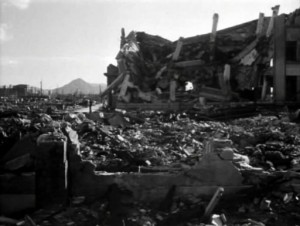Hiroshima Peace Memorial Museum shares Soviet footage of A-bomb damage
Aug. 5, 2016
by Kyosuke Mizukawa, Staff Writer
On August 4, the Hiroshima Memorial Peace Museum, located in Naka Ward, released to the media black-and-white footage of the devastation of Hiroshima and Nagasaki that was captured by an investigation team from the former Soviet Union in the autumn of 1945. The film was presented to the Japanese government by Russia’s House Speaker Sergei Naryshkin when he visited Japan this past June, then provided to the City of Hiroshima. It is the first time that the museum has received footage of the A-bomb damage taken by the former Soviet Union.
The running length of the film is nearly five minutes, with approximately one and half minutes showing Hiroshima. The footage includes the ruins believed to be the Hiroshima Fukokukan (now part of Naka Ward), located about 330 meters from the hypocenter, and the Hiroshima Postal Savings (now also part of Naka Ward), about 1.6 kilometers from the hypocenter. The film also shows the collapsed building of the headquarters of the Hiroshima Gas Company, 210 meters from the hypocenter, and close-up shots of debris and rubble near the hypocenter.
According to the museum, it is assumed, judging from the amount of damage to the foot of the Motoyasu Bridge, that the footage of Hiroshima was taken from October to November after the deadly Makurazaki Typhoon hit the city on September 17, 1945. The Nagasaki footage shows the landscape near the hypocenter and the investigation team inspecting the ruins of the city. The film also includes footage of U.S. nuclear tests that are held at the U.S. National Archives.
A museum curator said, “The footage shows scenes we have already seen in other videos and photos. But this film tells us for the first time that Russia now has film captured by the former Soviet Union. We hope to investigate further in Russia about other materials related to this footage if they will cooperate in this research.” The Peace Memorial Museum may show the film to the public when the east building reopens next February after current renovation work has been completed.
(Originally published on August 5, 2016)
On August 4, the Hiroshima Memorial Peace Museum, located in Naka Ward, released to the media black-and-white footage of the devastation of Hiroshima and Nagasaki that was captured by an investigation team from the former Soviet Union in the autumn of 1945. The film was presented to the Japanese government by Russia’s House Speaker Sergei Naryshkin when he visited Japan this past June, then provided to the City of Hiroshima. It is the first time that the museum has received footage of the A-bomb damage taken by the former Soviet Union.
The running length of the film is nearly five minutes, with approximately one and half minutes showing Hiroshima. The footage includes the ruins believed to be the Hiroshima Fukokukan (now part of Naka Ward), located about 330 meters from the hypocenter, and the Hiroshima Postal Savings (now also part of Naka Ward), about 1.6 kilometers from the hypocenter. The film also shows the collapsed building of the headquarters of the Hiroshima Gas Company, 210 meters from the hypocenter, and close-up shots of debris and rubble near the hypocenter.
According to the museum, it is assumed, judging from the amount of damage to the foot of the Motoyasu Bridge, that the footage of Hiroshima was taken from October to November after the deadly Makurazaki Typhoon hit the city on September 17, 1945. The Nagasaki footage shows the landscape near the hypocenter and the investigation team inspecting the ruins of the city. The film also includes footage of U.S. nuclear tests that are held at the U.S. National Archives.
A museum curator said, “The footage shows scenes we have already seen in other videos and photos. But this film tells us for the first time that Russia now has film captured by the former Soviet Union. We hope to investigate further in Russia about other materials related to this footage if they will cooperate in this research.” The Peace Memorial Museum may show the film to the public when the east building reopens next February after current renovation work has been completed.
(Originally published on August 5, 2016)








